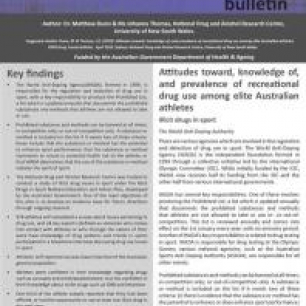Key findings
- The World Anti-Doping Agency(WADA), formed in 1999, is responsible for the regulation and detection of drug use in sport, with a key responsibility to produce the Prohibited List, a list which is updated annually that documents the prohibited substances and methods that athletes are not allowed to take or use.
- Prohibited substance and methods can be banned at all times; in-competition only; or out-of-competition only. A substance or method is included on this list if it meets two of three criteria: these include that the substance or method has the potential to enhance sport performance; that the substance or method represents an actual or potential health risk to the athlete; or that WADA determines that the use of the substance or method violates the spirit of sport.
- The National Drug and Alcohol Research Centre was funded to conduct a study of illicit drug issues in sport under the Illicit Drugs in Sport National Education and Action Plan, developed by the Australian Government. One of the main objectives of this plan is to develop an evidence base for future directions through ongoing research.
- 974 athletes self completed a survey about issues pertaining to drug use, and 24 key experts (defined as someone who comes into contact with athletes or who through the nature of their work have knowledge of drug patterns and trends in sport) participated in a telephone interview discussing drug use issues in sport.
- Athletes’ self-reported use was lower than that of the Australian general population.
- Athletes were confident in their knowledge regarding drugs such as cannabis and meth/amphetamine, but less confident in their knowledge about niche drugs such as GHB and ketamine.
- One-third of the athlete sample reported that they had been offered, or had the opportunity to use at least one illicit drug in the past year.
- Key experts felt that education should focus on ‘party’ drugs, the most readily available drugs and the drugs athletes are more commonly detected using.
- Athletes believed that there should be separate policies regarding being caught using ‘recreational’ drugs and ‘performance-enhancing’ drugs.


